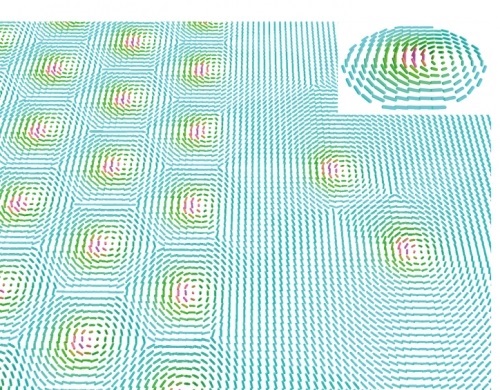2017.08.29
Liquid crystals, now found everywhere in flat TVs and mobile phones, are also an important research subject of physics, because they spontaneously form various ordered structures. Prof. Jun-ichi Fukuda at Kyushu University (formerly at National Institute of Advanced Industrial Science and Technology (AIST)), in collaboration with researchers at National Academy of Science (Ukraine), University of Ljubljana and Jožef Stefan Institute (Slovenia), showed for the first time, both theoretically and experimentally, that swirl-like structures known as half-Skyrmions (Fig.1) are spontaneously formed in a thin film of a liquid crystal.
Skyrmions, swirl-like vectorial order without singularities, have been known to emerge in diverse condensed matter systems, and particularly those in ferromagnets have been attracting growing attention. The research group of Prof. Fukuda previously showed the possibility of the formation of half-Skyrmions (Fig.1) in a thin film of a liquid crystal theoretically, and the present research experimentally demonstrated their formation by optical microscope observations (the size of a half-Skyrmion was a few hundred nanometers, close to the resolution limit of optical microscopy). Theoretical calculations on the ordered structures of a liquid crystal, and their resulting optical microscope images corroborated the experimental observations. It was also shown that half-Skyrmions not only form a regular lattice but also can exist as isolated entities (Fig.1).
These results in the present study show novel features of liquid crystals as structural and optical materials, and the theoretical calculations in the research extend the possibility of optical microscopy for the observation of submicron-scale objects.
For more information, see Nych, Fukuda et al., “Spontaneous formation and dynamics of half-Skyrmions in a chiral liquid crystal film,” Nature Physics (DOI: 10.1038/NPHYS4245)
Spontaneous formation and dynamics of half-skyrmions in a chiral liquid-crystal film,NATURE PHYSICS,
10.1038/nphys4245













